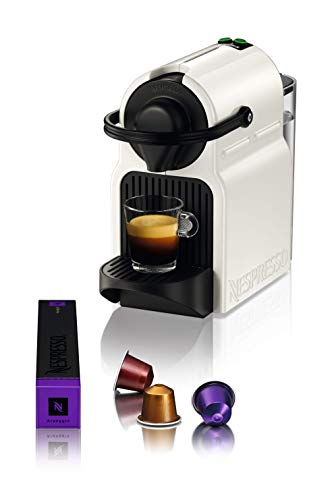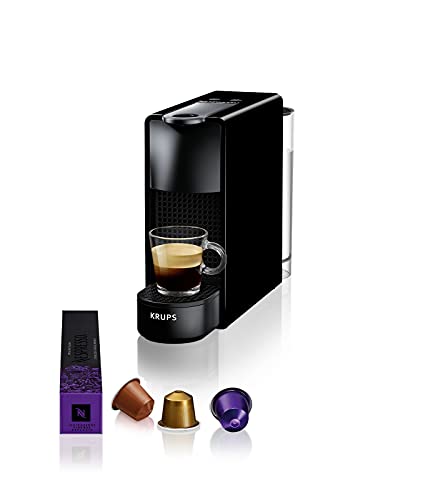Free Board
- 제목 :
-
The Main Problem With Nespresso Coffeee Machine And What You Can Do To Fix It
- 2024.05.25
 nespresso machine Magimix Coffee - The Essenza Mini
nespresso machine Magimix Coffee - The Essenza MiniThe Essenza Mini is compact and affordable. It's also simple to use. It does not have an adjustable drip tray or water tank to keep it small. However, it is a great espresso and lungo.
 It works by piercing capsules and pumping water under pressure. This results in different sizes of espresso as well as coffee drinks, including 1.35-ounce espressos, 2.7-ounces double espressos, 5-ounces gran lungos or 14-ounces altos. It can also work with a stand-alone milk frother.
It works by piercing capsules and pumping water under pressure. This results in different sizes of espresso as well as coffee drinks, including 1.35-ounce espressos, 2.7-ounces double espressos, 5-ounces gran lungos or 14-ounces altos. It can also work with a stand-alone milk frother.Capsules
The Nespresso system lets you create coffee at the click of the button. You can choose between the single-serving cup or a larger size, and each capsule is filled with the right amount of beans to give you the strength you want. You can also add milk powder to make a cappuccino or macchiato latte. The capsules are recyclable or disposed of without guilt as they are made from biodegradable materials.
The pods are made of aluminum and are able to stand up to the pressure of the machine. The pods are sealed with a hermetically sealed seal, and the coffee grounds inside remain fresh and protected from moisture and oxygen. Additionally, the aluminium is 100% recyclable, which aligns with Nestle's sustainability objectives.
However the system isn't without its flaws. The machines are expensive both to purchase and operate. The capsules are also costly to purchase and have to be replaced often. Also, capsules are only compatible with Nespresso-branded capsules. This has led to a variety of lawsuits between Nestle and third-party companies, that use the same extraction process and ingredients as Nespresso.
Despite these drawbacks, the Nespresso System is not without advantages. It is a top-quality coffee and sustainability in the environment. It's an excellent alternative to traditional coffee and tea bags, and has a much higher extraction rate than other single-serve systems. In reality, a single capsule can make up to 14 ounces of espresso coffee.
The first capsule was designed in 1976, and then patented in 1978. Its main features include an outer cone of aluminum foil, a flat top with a cylindrical recess into which the machine injects hot water, and a narrow opening in the base that is punctured from above and below. The machine spins the capsule at 7000 rpm, which infuses the coffee with water, resulting in the thicker crema.
Water
When you use a Nespresso machine, it's essential to have high-quality water. This ensures consistent quality, and is also important for taste and texture. In general, you should choose water that is "filtered" or "spring," and avoid tap or distillation water.
In our laboratory tests, we found that machines with softened water produce more satisfying espressos and lungos than machines that use hard water. Hard water can cause calcium deposits, as well as other problems that can alter the taste of your coffee.
During each cup during each cup, the Nespresso coffee machine releases hot water under high pressure. This process is known as extraction. The duration, temperature and pressure of the extraction process is the factors that determine the flavor and intensity of your coffee.
The Original machines pierce the capsule and then push it, while the Vertuo model reads the barcodes to determine the amount of water needed for each kind of espresso. The Vertuo machines can brew six different sizes of drinks including espressos and macchiatos latte, with or without foam.
All the machines that are part of the Nespresso range provide 19 bars of pressure. Some of the more expensive models can also make cappuccinos and latte macchiatos and some models even provide the option of making Iced Coffee.
Inissia machines and U-series machines are compact which makes it easy to fit them into small spaces. The nespresso vertuo coffee machine Pixie is another compact option that comes with a built-in milk maker. It can be used in conjunction with Nespresso's app to get customized recipes and reorder capsules. Nespresso makes a great choice for those looking to reduce their plastic footprint while supporting the company's sustainability initiative.
Temperature
Nespresso machines are more complex than your average coffee maker, but they're designed to be quick and simple to use. They operate very quickly taking only a few minutes to prepare each capsule. They are also relatively energy efficient. Nespresso machines consume less energy than traditional drip coffee makers to brew the capsules.
Certain models of Nespresso coffee machines include a milk frother which can be used to make lattes and cappuccinos. Some of these models also come with a capsule container that can hold up to 12 empty capsules at a time, nespresso machine Inissia which makes them easy to recycle.
The Nespresso brand is backed by several well-known kitchen-equipment manufacturers such as Krups, DeLonghi and Breville. However, the majority of the machines are made by Eugster/Frismag which is a Swiss company that is one of the world's largest coffee-machine producers. This has led to criticism of the company's use patents and other similar strategies like those employed by printer manufacturers to create vendor lock-in.
Pressure
To get the best espresso, you need to maintain a constant pressure throughout the extraction. This is called "pressure profiling" and involves altering the pressure applied to the ground to maximize flavor and achieve the highest extraction. This method is possible by using various espresso machines, including Nespresso coffee makers.
There are many ways espresso machines can alter the pressure of extraction. One approach is a balanced bypass, which regulates water pressure to a fixed value (typically 9 bar), regardless of the inlet pressure. This is a simple and efficient technique that guarantees that all of the espresso groups are at the same pressure throughout the extraction process.
A control knob or lever can be used to adjust pressure manually. This is a more difficult method, but it does provide a greater degree of flexibility and control. Manual pressure regulation can result in inconsistent results. It requires a great deal of expertise and focus.
Some espresso machines use dynamic pumps to adjust the pressure according to the temperature of the coffee grounds as well as the type being employed. This is a much more sophisticated system, but it can yield more consistent results than other types of espresso machines.
Nespresso offers a range of machines that can create lungo and espresso drinks, and some can also make milk froth. The Nespresso Inissia is a fantastic option for baristas at home because it can make between seven and nine espressos at a time. It also has a 33-ounce tank for water. The machine also has buttons for different sizes of drinks, and comes with a capsule tray that holds up to nine pods that have been used. The Nespresso Vertuo Next is designed for versatility and has eleven milk temperatures as well as eight milk textures to choose from. It also comes with stainless steel milk frother and a container which can hold up to 18 inches.
Cleaning
Every time you use a Nespresso it will leave behind mineral and limescale residues. These residues can get mixed with your coffee, causing it to taste bad. To prevent this, it is important to clean regularly your Nespresso machine and its components. A thorough clean is required, which includes washing and descaling the removable parts, like the drip tray and capsule container. A regular rinse with fresh water can aid in preventing the buildup of minerals and enhance flavor.
Using a de-scaling solution can help eliminate mineral deposits from your machine. These products are available in a variety of appliance and coffee stores. You can also make use of vinegar. This versatile cleaner won't harm your machine, however it may take longer for the minerals to dissolve than the descaling solution.
If you choose to use vinegar, you must remove the coffee pods first, then empty the reservoir. Then, empty the rest of the water in the tank as well as any water filters that are built-in to the tank. Pour the vinegar in and run a cycle with out coffee pods so that it can pass through the machine. Rinse the machine using clean water, and run several cycles to ensure that there aren't any vinegar remnants left.
Once you have your machine clean it is time to clean the exterior and removable parts. Pay particular attention to crevices and corners, where gunk can hide. Wash the removable parts in the dishwasher or hand wash them using mild soap and water. Make sure to thoroughly rinse. Examine the seals on the capsule as well as the coffee outlet and replace them if they are damaged to maintain their elasticity.